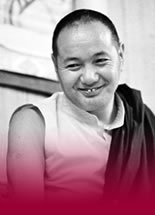Robina’s Blog
17 February, 2022
Buddha talks about how things exist in two ways – well, many ways, actually. But this particular way of presenting it, he calls the two truths: conventional truth, the way things exist conventionally; and the way things exist finally, or ultimately. Initially when we hear these, they seem totally contradictory. But in reality, they are like flip sides of the same coin, and our job is to get to see that, to understand that, first intellectually.
The shorthand for how things exist conventionally is “dependent arising,” or “dependent origination.” Things exist interdependently. Things exist in dependence upon this and that, conventionally. And then ultimately, the shorthand is “emptiness”: “emptiness” is the nature of reality ultimately. This is the way they talk.
Let’s unpack these ideas, let’s look at the use of these words, because part of our problem is we don’t even know how these words are used. We can’t get our head around the general concepts. You know, thirty years of hearing Buddhism, we still haven’t got a clue what emptiness is because we haven’t even technically got ourselves sorted out, how to use this terminology. We mystify it.
Establish what exists In Buddhist philosophy there are several synonyms for “that which exists” – and Buddha is all about our discovering “that which exists.” That’s his big thing. Because he says we’re in la-la land right now, believing in things that don’t exist.
Whatever does exist is necessarily a phenomenon, an object, an existent. The definition of an existent is “that which can be cognized by mind,” a valid state of mind, obviously – and there are precise ways of defining what is valid and what is not. And what we’re attempting to do in this pursuit of wisdom is to eventually cognize all existents precisely as they exist, no more and no less: that’s omniscience.
So, you agree, right, that there is an existent, a thing that can be cognized by the mind, called white? And it exists here on this cup, yes? Would you agree with that? White does exist here on this cup, doesn’t it? It is something that your mind can cognize.
Okay, how do we know it exists? Well, we have to first establish it conventionally. We need to label it, define it, then check that it fulfills the definition and make sure there are no other valid cognitions of it that contradict this. Then we can all shake on it and agree that this object, this phenomenon called white, exists here on this cup.
Cognizing the absence of something Let’s say I am color-blind and when I look at white I see red. I’m making a mistake, aren’t I? Remember, we’ve established the existence of this conventional phenomenon called white by defining, etc., etc., and agreeing upon that – that’s what “conventional” means: by convention it’s called white.
When I see a red cup when you show me a white one, I am making a mistake. I am seeing something that doesn’t exist, but which I totally believe does exist. You can’t just bully me into believing it; you have to help me to see the truth. And how do you do that? You help me correct the mistakes: you check my eyes, my glasses, the lighting, the various dependent arisings. You fix the problem. Then I look again at the cup and what will I see?
Well, interestingly I will not see white, at least not initially. Because I’m so used to seeing red, I’ll get a big shock – “Oh my God, the cup is not red!” In other words, what I see is the vivid phenomenon called “the emptiness of red.” I will cognize the absence of red on that cup. Makes sense, doesn’t it?
When we hear “emptiness,” we tend to think of it as meaning “nothing.” But the “emptiness of red” is a very vivid thing that does exist, isn’t it? But for whom? It’s obvious that this is only relevant to someone who always saw red when white was in front of them. Now, having fixed the problem, that person will see the absence of the thing they always thought was there.
Absence of keys Let me give you another example. Let’s say you are running late and you rush to the front door and on the way you open the drawer where you always keep your car keys. You know the keys are there, you totally expect the keys in the drawer. But when you open the drawer you get a big shock. “Oh my God! No keys!” What did you just see in the drawer? The absence of keys, the emptiness of keys. It’s a very vivid thing, isn’t it?
Now, if I look into your drawer and I’m not expecting keys, all I will see is a boring drawer with nothing in it. I see nothing. But you see something very vivid – the absence of a thing that you thought was there. And that’s the idea about emptiness. And the only person who will see that vivid thing called emptiness of keys is the person who expects keys to be there, who believes keys are there. Seeing nothing is nihilism.
Absence of $10,000 An even more vivid example. Let’s say you have been saving your dollars: every day your savings account grows and finally reaches ten thousand dollars. You know it’s there with such certainty.
But one day you open up your bank statement online and all there is there is zero. But believe me, you won’t see zero dollars! You will vividly, shockingly see the absence of your precious ten thousand dollars! The emptiness of ten thousand dollars is a very vivid thing for you.
Absence of the inherent self Buddha is saying, “Robina, you need to cognize the emptiness of the self-existent I.” Why? Because for eons I have been imposing on my self – the conventional self that does exist – a characteristic that doesn’t exist there. The mistake we make – our ignorance makes – is seeing an inherently existent self where there isn’t one. And we do this with everything. We see an inherently existent cup where there isn’t one, an inherently existent dog where there isn’t one, an inherently existent everything, where there isn’t one. We’ve been decorating on top of what does exist – a conventional I, a conventional cup – the characteristic called inherent existence, which doesn’t exist and never has. Buddha wants us to see that absence, that emptiness.
And where does that absence of an inherently existent I exist? On the conventional I that does exist. Just like the absence of the red cup exists on the white cup that does exist, and the absence of ten thousand dollars exists right there in the bank account of zero dollars.
The big mistake Buddha’s saying that for eons we have been believing in this big mistake. Where did you learn this? We didn’t. We’ve believed it since beginningless time. And all of our suffering, all our attachment, all our anger, all our pride, all the wars, all the dramas, all the rebirths – all are the consequence of this misconception. This misconception is the primordial misconception that is the source of all suffering.
But we can’t see it, because it’s totally assumed as the truth. It’s the default mode in our minds. We can’t even begin to comprehend the meaning of “I see myself as inherent.”
“Seeing emptiness” is a very meaningful way to say it. It’s the emptiness of the fantasy “I” that you thought was there. And, just like with the keys, or the dollars or the red, the person who’d see the absence of the inherent I is, of course, the person who always believed it was there.
You would see the absence of your inherent I only if you had clung to and believed in an inherent I, in the first place. It has nothing to do with vacuous space, vague nothingness. It’s a very vivid, vivid thing, when you can get it.
When you see a zero in your bank statement but totally expected $10,000, you won’t see zero dollars, for sure! That’s nihilism, which we often mistakenly think is the meaning of emptiness: as if we chucked all the dollars and ended up with nothing. No! It’s not like that! You will vividly see the absence, the emptiness, of ten thousand dollars.
As His Holiness says, it’s not as if when we search for the inherent I, the I that we think exists, that we throw out everything and end with nothing. Not at all. When we search for the I among the aggregates, our parts, what we find is the massive thing called the absence, the emptiness of the I that we always thought existed.
Of course, the emptiness of this inherent I is far more radical than the emptiness of red or ten thousand dollars; red can exist, ten thousand dollars can exist, but that kind of I could never exist.
Buddha’s telling us that we need to cognize the emptiness of the inherent I, it is not some fancy religious trip he’s putting on us; it’s not some abstract construct. It’s utterly experiential.
And the realization of it is what cuts the root of suffering.

